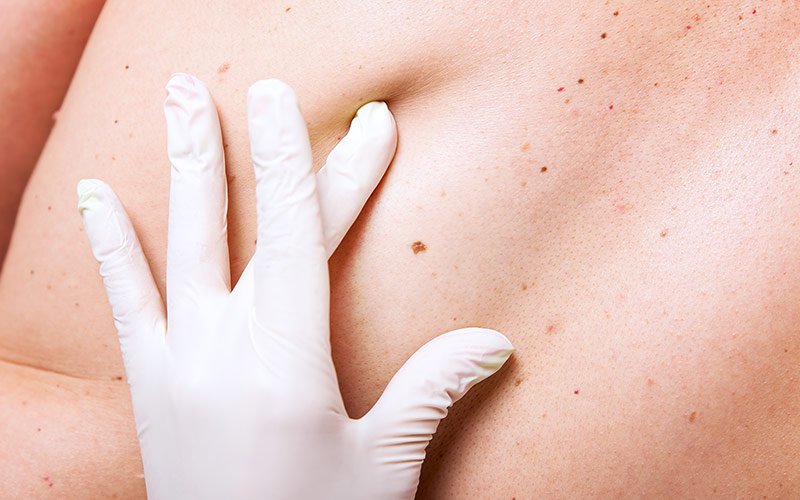It is not uncommon for early skin cancer to be dismissed as a stubborn acne bump or even go unnoticed because obvious symptoms are often absent. When left untreated, skin cancers will keep growing and can lead to disfigurement or loss of function. In some cases, skin cancers can metastasize and become life-threatening. Fortunately, the majority of skin cancers are curable if treated early on.
Dermatologist and Mohs surgeon Jennifer Ranario, MD recommends regular skin checks to aid in earlier detection as an important way for patients to stay healthy and possibly avoid more serious and involved treatments.
You probably know that a full skin exam by a board-certified dermatologist is the best way to catch skin cancer early, which is also when it’s most treatable. So why have you been putting it off? It’s easier than you think.
To prepare for the exam, it’s best to either come to your appointment without foundation or makeup or to remove it at your appointment. The better the doctor can see your natural skin, the more effective the exam will be. Also, it’s helpful to make note of any areas that stand out to you. Patients are often very good at noticing when there has been a change, so any areas you identify will require special attention.
At the appointment we’ll ask some questions about your history of sun exposure, sunburns, etc. and ask if any specific moles or other spots have been worrying you. Then we’ll have you change into an exam gown (or exam shorts for men).
Since skin cancer can occur anywhere on your body, the exam is a “head-to-toe” affair. Typically the doctor will start in your hair, paying close attention to the ears, nose, and back of the neck since those are common areas for excess sun exposure.
It is possible to have skin cancer even in areas that don’t get a lot of sun exposure, so the doctor will adjust your gown to systematically examine the skin on each area of your body. Even between your fingers and toes and the bottoms of your feet!
Occasionally patients prefer a more limited exam (say, just the waist up, or only certain moles) and of course, we can accommodate. Undergarments can be worn during the exam if preferred. Don’t let shyness keep you from coming in!
As the doctor performs the exam, they may use a hand-held dermatoscope, which is a specialized device used to magnify and illuminate the various layers of the skin. They will also dictate their findings to a medical assistant who makes sure that everything is documented in your medical record. Don’t worry that the doctor might seem to be scanning each area of the body quickly. Dermatologists spend three years after medical school focused on identifying concerning moles, so they’re quite expert at discerning which ones need attention.
Dr. Ranario realizes that sometimes it may appear that your dermatologist has ignored a spot, but says it is likely that it’s being passed over because the main goal is to find any suspicious appearing lesions. When your dermatologist comes to a spot that you are worried about, Dr. Ranario suggests pointing it out so that any concerns that you may have can be addressed.
If you have a lot of suspicious moles, the doctor may want to document them with a photograph. The photograph is securely stored in your medical chart so that the size and nature of any moles can be compared at future visits.
As the doctor is performing the exam they might identify an area that needs treatment. After discussing the diagnosis and treatment with you, they will generally take care of the minor procedures right then and there. The two most common treatments are:
- Cryotherapy – A quick spray of liquid nitrogen is used to remove lesions that sit on the surface of the skin (for example, pre-cancerous actinic keratosis)
- Skin biopsy – A small sample of a suspicious lesion is removed under local anesthetic. It is then sent to a lab to be examined under a microscope to determine if further treatment is needed
Many people have lots of spots on their skin that are not worrisome (for example, skin tags, sunspots, and benign moles). Although these can be treated if they are causing discomfort, or if there is a cosmetic concern, the doctor generally focuses on any spots that have the potential to be cancerous. If you have something on your skin that bothers you, let the doctor know and they can talk to you about treatment options.
At the conclusion of the exam, the doctor will discuss any findings or treatment recommendations. Based on the exam and your personal history, they’ll make a recommendation about how often you should have your skin examined by a dermatologist.
Dr. Ranario urges people not to be afraid to come in for a skin check, since the earlier you have things treated, the easier the treatment is. A skin check by a dermatologist does not take long but is an effective way to help find and treat pre-cancerous lesions and early skin cancers. To Dr. Ranario and everyone at our practice, your health is our main concern, so we can adjust the exam to what you are comfortable with.
Looking to get a Skin Cancer Screening?
We have multiple locations throughout the country, so fill out our simple online form to get in touch with us. One of our local team members will reach out to you shortly to answer your questions or schedule an appointment for you to visit us soon.
Find a location near me
or

